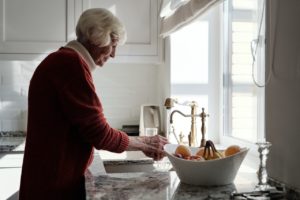Case Study – My Patient’s Dying
Print this case study here: Case Study – My Patient’s Dying
Case Study: My Patient’s Dying
By Molly Daughety (4th year Medical Student),
with Tarris Rosell, PhD, DMin
I had never seen it before. I had no experience on which to base my unsettling suspicions. And yet, it was unmistakable. My patient, Ms. P, was dying right in front of me.
I later learned the tell-tale signs: labored breaths, bluetinged skin, disorientation—all of which this patient displayed. She drifted in and out of consciousness and had difficulty staying awake long enough to answer questions.
“Do you have any headache or dizziness? Any nausea or vomiting?”
I shook her awake to repeat, “How’s your pain today?”
Ms. P responded, “My dear, your hands are so cold.”
She placed my hands between her own to warm them, then drifted back to sleep. I woke her once more to ask if there was anything I could do for her.
“I just don’t want to be alone,” she replied.
That was the moment when I became aware of what was happening. Ms. P was dying. She was passing from this life in front of my eyes, doing so without family or friends to comfort and accompany. I sat with her until she drifted back to sleep.
But then I left the patient’s room. There were others to see. Rounds to join.
Before moving down the hallway to rejoin the oncology team, I stopped to ask a nurse for Ms. P’s brother-in-law’s phone number. I knew that he had been her only regular visitor during this hospitalization. Then I called the number. When Mr. P answered, I told him who I was, and inquired as to whether he was planning to stop by the hospital today.
“Yes,” he said, “I was planning to come after lunch.” Mr. P paused, then asked, “Unless, you think I should come sooner?”
I did not want to worry him unnecessarily and was afraid I had already overstepped the bounds. Was it appropriate for a medical student to call a patient’s family like this, even if she was dying, on just my fifth day on the wards?
“I’m not sure,” I said to Mr. P. “Your sister-in-law just said she doesn’t want to be alone. So, as soon as you could come . . . would be good,” I fumbled.
After we hung up, I ran to join the rest of the oncology team for sit-down rounds. I was late. Five minutes into that meeting, a loud noise sounded in the hallway and the conference room telephone rang. As the attending physician picked up the phone, his jaw dropped. He shot up from the table and started speed walking down the hallway. Like well-trained recruits, we all followed.
The doctor entered a room with a blue light flashing above the doorway. He shouted, “Stop! Stop everything. She’s DNAR.”
The code procedure stopped, and the large code team backed away from the bed revealing Ms. P, sprawled out on her back, stripped naked but for the bright purple DNAR bracelet on her wrist. Her eyes and mouth were frozen wide open.
What surprised me first was how different she looked from the last time I’d seen her. Was it really just a few minutes ago that she had said to me, “My dear, your hands are so cold”? Body and face were mostly unchanged, but still Ms. P looked entirely different now without life behind her eyes.
What struck me next was how terrible it was that she died the way she did, exposed and vulnerable to the gaze of twenty-plus spectators. The DNAR bracelet had also been exposed, in clear view. How then had this happened? Why did no one, until the attending arrived, say, “Stop!”?
I suddenly felt guilty, both about being there and then also about not having been there. Being there now seemed like an intrusion on one of the most private events of a person’s life, that moment of passage, of dying. I had not asked nor earned permission to be present.
But worse yet, Ms. P had asked me to be there, implicitly anyway. She had said, “I just don’t want to be alone”—which I interpreted as not wanting to be left alone to die. Had I not left regardless? Could I have done otherwise? Would it have mattered? So many questions.
So much to learn.
Questions for discussion
1. What morals are conflicted in this case situation?
2. Who is responsible for ensuring that Ms. P’s dying wishes are fulfilled to the degree possible?
3. For what and to whom is this third-year medical student responsible? What is owed the patient by a medical student?
4. What is the attending’s responsibility in regard to this patient, and student?
5. Was the student wrong to call Ms. P’s brother-in-law?
6. If the patient was DNAR, why did the code team commence in running a code blue? How could this happen?
7. How might the situation have been handled differently? How might someone have prevented the negative aspects of Ms. P’s dying?
8. What, if anything, does any of this have to do with biomedical principles of justice, respect for persons’ autonomy, beneficence, or nonmaleficence?



